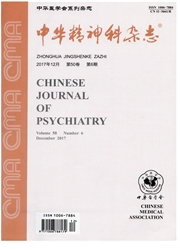

 中文摘要:
中文摘要:
目的探讨促肾上腺皮质激素释放激素结合蛋白(corticotropin—releasing hormone binding protein,CRHBP)基因多态性与选择性5-羟色胺再摄取抑制剂(selective serotonin reuptake inhibitors,SSRIs)疗效的相关性。方法对符合《美国精神障碍诊断与统计手册(第4版)》重度抑郁症诊断标准的207例抑郁症患者予以SSRIs常规剂量治疗6周,以治疗后17项汉密尔顿抑郁量表(Hamilton Depression Scale,HAMD17)总分减分率作为评估疗效的指标,将入组患者分为有效组(HAMDl7减分率I〉50%)和无效组(HAMD17减分率〈50%);采用TaqMan探针法对CRHBP基因上的5个单核苷酸多态(single nucleotide polymorphisms,SNP)位点进行基因分型,比较有效组和无效组5个位点基因型及多位点组成单倍型的不同。结果(1)治疗第4周末:CRHBP基因5个SNPs的基因型、等位基因频率及单倍型分析在不同疗效患者组问分布差异均无统计学意义(P均〉0.05)。(2)治疗第6周末:CRHBP基因rsl715751和rs32897位点的等位基因频率在有效组和无效组之间的差异有统计学意义(X2=4.185,P=0.041;x2=5.191,P=0.023);rsl715751位点携带cT+cc基因型的患者在治疗有效组(75/151,49.7%)的频率显著高于无效组(7/31,22.6%;)(X2=9.324,P:0.004;校正后P=0.020);rs32897位点携带CT+CC基因型的患者在治疗有效组(63/151,41.7%)的频率显著高于无效组(7/31,22.6%;)(2:4.905,P=0.029,校正后P=0.145)。(3)治疗第6周末:有3种单倍型在治疗有效组和无效组之间的分布差异有统计学意义,分别是C—C(rsl715751-rs3792738,P=0.024,校正后P=0.12;rs3792738-rs32897,P=0.013,校正后P=0.065),C—C—C(rsl715751-rs3792738-rs32897,P=0.022,校正后P=0.110)。结论CRHBP基因多态性可能与SSRIs的疗效相关。
 英文摘要:
英文摘要:
Objective To investigate whether the corticotropin-releasing hormone binding protein (CRHBP) gene polymorphisms is associated with the therapeutic response to selective serotonin reuptake inhibitors (SSRIs) in patients with major depressive disorder. Methods Routine dosage of SSRIs was given by six weeks to 207 patients who was diagnosed as major depressive disorder(MDD) according to Diagnostic and Statistical Manual of Mental Disorders Fourth Edition ( DSM-IV ) criteria. The Hamilton Depression Rating Scale 17 (HAMDj7) was used to assess the illness severity before and after the treatment. The patients were grouped into responder ( reduction rate of HAMDj7 score I〉 50% ) and non-responder(reduction rate of HAMD17 score 〈 50% ). TaqMan MGB was used to analyze the differences of the 5 SNPs polymorphisms between the responder group and non-responder group. Results ( 1 ) At weeks 4, there was no statistically significant difference in the 5 CRHBP polymorphism genotypes, allele frequency and haplotype analysis between the two MDD groups with different responsiveness to SSRIs ( P 〉 0.05 ). (2) At weeks 6, allele frequency analysis of rs1715751 and rs32897 was statistically significant between the responder group and non-responder group (X2 =4. 185,P =0.041, X2 =5. 191 ,P =0. 023). The frequency of CT + CC genotype carriers of rs1715751 were higher in responder group than that in non-responder group (75/151,49.7% and 7/31,22.6% respeetively,x2 =9. 324,P =0. 004; after Bonferroni Correction , P = 0. 020). The frequency of CT + CC genotype of rs32897 in responder group was higher than that in non- responder group ( 63/151,41.7 % and 7/31,22.6% respectively, X2 = 4. 905, P = 0. 029 ; after Bonferroni Correction, P = 0. 145 ). (3) At weeks 6,three haplotypes were associated with SSRIs therapeutic response in haplotype analyses including C-C ( rs1715751-rs3792738, P = 0.024 ; adjusted P = 0. 120 ; rs3792738-rs32897, P = 0. 013 ; adjusted P = 0. 065 ), C-C
 同期刊论文项目
同期刊论文项目
 同项目期刊论文
同项目期刊论文
 期刊信息
期刊信息
